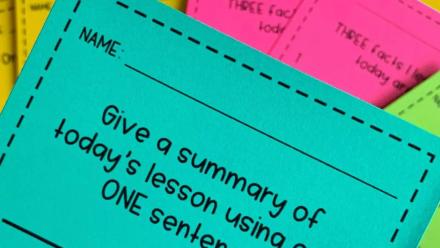Key Information
Focus
When To Use This Strategy
Appropriate Group Size
Why use exit slips?
- They provide teachers with an informal measure of how well students have understood a topic or lesson.
- They help students reflect on what they have learned.
- They allow students to express what or how they are thinking about new information.
- They teach students to think critically.
How to use exit slips
At the end of your lesson ask students to respond to a question or prompt.
Note: There are three categories of exit slips (Fisher & Frey, 2004):
- Prompts that document learning:
— Example: Write one thing you learned today.
— Example: Discuss how today’s lesson could be used in the real world. - Prompts that emphasize the process of learning:
— Example: I didn’t understand…
— Example: Write one question you have about today’s lesson. - Prompts to evaluate the effectiveness of instruction:
— Example: Did you enjoy working in small groups today? - Other exit prompts include:
— I would like to learn more about…
— Please explain more about…
— The thing that surprised me the most today was…
— I wish…
- Prompts that document learning:
- You may state the prompt orally to your students or project it visually on an overhead or blackboard.
- You may want to distribute 3 x 5 cards for students to write down their responses.
- Review the exit slips to determine how you may need to alter your instruction to better meet the needs of all your students.
- Collect the exit slips as a part of an assessment portfolio for each student.
Download blank template
Collect resources
See how one third grade teacher uses exit slips with her “What Stuck With You Today?” board.
Content area exit slip examples
- Write one thing you learned today
- Write one question you have about today’s lesson
- Write three words with the long “o” sound
- Why are the North and South Pole so cold?
- Explain why Canada is not considered a melting pot
- Draw a quick diagram that shows perspective
- Of the 3 graphs we studied today which one did you find most useful? Why?
- Name one positive and one negative thing that happened during group work today
- Multiply 3 by 4
Find more information about exit slips from ReadWriteThink.
Differentiated instruction
For second language learners, students of varying reading skill, and younger learners
- Have a variety of exit slips and differentiate which students get which ones
- Allow students to work on their exit slips in pairs or small groups
- Allow students to verbally express the information
See the research that supports this strategy
Bafile, C. (2004). “Let It Slip!” Daily Exit Slips Help Teachers Know What Students Really Learned.
Fisher, D., and Frey, N. (2004). Improving Adolescent Literacy: Strategies at Work. New Jersey: Pearson Prentice Hall.
Children’s books to use with this strategy

Teammates

The Other Side

